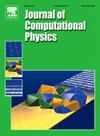A flexible GMRES solver with reduced order model enhanced synthetic acceleration preconditioner for parametric radiative transfer equation
IF 3.8
2区 物理与天体物理
Q2 COMPUTER SCIENCE, INTERDISCIPLINARY APPLICATIONS
引用次数: 0
Abstract
Parametric radiative transfer equation (RTE) occurs in multi-query applications such as uncertainty quantification, inverse problems, and sensitivity analysis, which require solving RTE multiple times for a range of parameters. Consequently, efficient iterative solvers are highly desired.
Classical Synthetic Acceleration (SA) preconditioners for RTE build on low order approximations to an ideal kinetic correction equation such as its diffusion limit in Diffusion Synthetic Acceleration (DSA). Their performance depends on the effectiveness of the underlying low order approximation. In addition, they do not leverage low rank structures with respect to the parameters of the parametric problem.
To address these issues, we proposed a ROM-enhanced SA strategy, called ROMSAD, under the Source Iteration framework in Peng (2024). In this paper, we further extend the ROMSAD preconditioner to flexible general minimal residual method (FGMRES). The main new advancement is twofold. First, after identifying the ideal kinetic correction equation within the FGMRES framework, we reformulate it into an equivalent form, allowing us to develop an iterative procedure to construct a ROM for this ideal correction equation without directly solving it. Second, we introduce a greedy algorithm to build the underlying ROM for the ROMSAD preconditioner more efficiently.
Our numerical examples demonstrate that FGMRES with the ROMSAD preconditioner (FGMRES-ROMSAD) is more efficient than GMRES with the right DSA preconditioner. Furthermore, when the underlying ROM in ROMSAD is not highly accurate, FGMRES-ROMSAD exhibits greater robustness compared to Source Iteration accelerated by ROMSAD.
基于降阶模型的GMRES柔性解算器增强了参数辐射传递方程的合成加速度预调节器
参数辐射传递方程(RTE)出现在不确定性量化、逆问题和灵敏度分析等多查询应用中,这些应用需要对一系列参数多次求解RTE。因此,我们非常需要高效的迭代求解器。经典的RTE合成加速度(SA)预调节器建立在对理想动力学修正方程的低阶近似上,如扩散合成加速度(DSA)中的扩散极限。它们的性能取决于底层低阶近似的有效性。此外,它们不利用相对于参数问题的参数的低秩结构。为了解决这些问题,我们在Peng(2024)的Source Iteration框架下提出了一个rom增强型SA策略,称为ROMSAD。本文将ROMSAD预条件进一步推广到柔性一般最小残差法(FGMRES)。主要的新进展有两个方面。首先,在确定FGMRES框架内的理想动力学修正方程后,我们将其重新表述为等效形式,允许我们开发迭代程序来构建该理想修正方程的ROM,而无需直接求解它。其次,我们引入了一种贪婪算法来更有效地为ROMSAD预条件构建底层ROM。数值算例表明,使用ROMSAD预条件的FGMRES (FGMRES-ROMSAD)比使用正确的DSA预条件的GMRES效率更高。此外,当ROMSAD中的底层ROM精度不高时,FGMRES-ROMSAD比由ROMSAD加速的源迭代表现出更强的鲁棒性。
本文章由计算机程序翻译,如有差异,请以英文原文为准。
求助全文
约1分钟内获得全文
求助全文
来源期刊

Journal of Computational Physics
物理-计算机:跨学科应用
CiteScore
7.60
自引率
14.60%
发文量
763
审稿时长
5.8 months
期刊介绍:
Journal of Computational Physics thoroughly treats the computational aspects of physical problems, presenting techniques for the numerical solution of mathematical equations arising in all areas of physics. The journal seeks to emphasize methods that cross disciplinary boundaries.
The Journal of Computational Physics also publishes short notes of 4 pages or less (including figures, tables, and references but excluding title pages). Letters to the Editor commenting on articles already published in this Journal will also be considered. Neither notes nor letters should have an abstract.
 求助内容:
求助内容: 应助结果提醒方式:
应助结果提醒方式:


